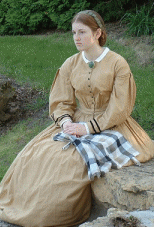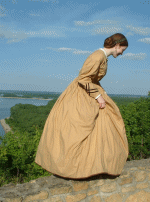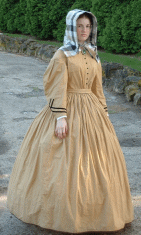|
Day Dress
with Velvet
Sleeve Trim
Click on pictures for larger view.

This dress I originally had made darted, but found later that
most gowns I've seen that were darted were not made of cotton, but
rather silk or wool. I have heard the same observation from many other
very reputable historians and have come to the conclusion that a darted
cotton dress is very rare. Since I had never worn the dress and I was
sure the area that had been darted would still be the same shade as the rest of the
fabric, I decided to take out the darts and make it into a gathered
bodice. I also changed the original bishop sleeves to a coat sleeve
with box pleats at the top of the sleeve. The side of the sleeves are
trimmed with brown velvet ribbon as seen in a
CdV of the era. The skirt is
gauged to the waistband and the hem employs brown hem braid. Hem braid
is another way to protect the dress and make it last longer. Its
purpose is to protect the hem of the dress and can be
removed and replaced with a new hem braid when it gets worn out. The collar acts in a similar
way, although the collar would be removed more frequently to be washed,
starched and pressed. A clean collar and cuffs add a nice finished
touch to every gown. People definitely were not stupid in the 19th
century and they sure knew how to make their clothing last.
had been darted would still be the same shade as the rest of the
fabric, I decided to take out the darts and make it into a gathered
bodice. I also changed the original bishop sleeves to a coat sleeve
with box pleats at the top of the sleeve. The side of the sleeves are
trimmed with brown velvet ribbon as seen in a
CdV of the era. The skirt is
gauged to the waistband and the hem employs brown hem braid. Hem braid
is another way to protect the dress and make it last longer. Its
purpose is to protect the hem of the dress and can be
removed and replaced with a new hem braid when it gets worn out. The collar acts in a similar
way, although the collar would be removed more frequently to be washed,
starched and pressed. A clean collar and cuffs add a nice finished
touch to every gown. People definitely were not stupid in the 19th
century and they sure knew how to make their clothing last.

In this last picture a slat bonnet is worn
with the dress. It is actually made of sheer cotton and is the perfect
bonnet for keeping the sun off of your face. Some people today believe it to
be unbecoming, but it was a very commonly worn accessory in this era
|



